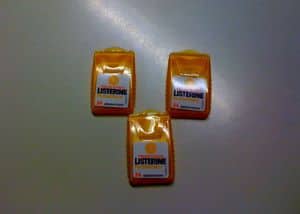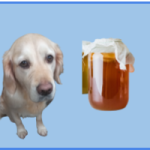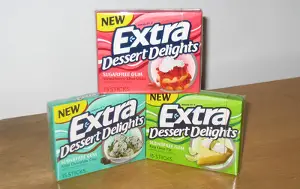
I get it. Your dog’s breath is so bad, you just want a quick fix. And maybe you’re thinking you can just give them a Listerine Pocketpaks ® breath strip.
Before you get to asking if you should go with fresh burst or cool mint flavour, let’s discuss this.
Are Listerine breath strips even safe for dogs?
First, we’ll look at:
- What are Listerine breath strips?
- What are the ingredients?
- Are any of the ingredients toxic to dogs?
Then we’ll deal with the root of the problem:
- Why do dogs have bad breath anyway?
- What are some ways to fix it?
Hey, maybe we’ll even discover there are breath strips made specifically for dogs (spoiler alert: there are).
What are Listerine breath strips?
Introduced to market by Pfizer in the fall of 2001, Listerine Pocketpaks ® breath strips are tissue-thin strips of polymer designed to dissolve in your mouth and freshen your breath – a convenient way to carry Listerine in your pocket, essentially.
One more thing – they’re made for humans.
What are the ingredients in Listerine Breath Strips?
Here they are:
Pullulan, menthol, sucralose, mentha viridis (spearmint) leaf oil, potassium acesulfame, glycerol oleate, polysorbate 80, copper gluconate, carrageenan, methyl salicylate, eucalyptol, thymol, flavor, ceratonia siliqua (carob) gum, glucose, propylene glycol, xanthan gum, green 3, yellow 6.
The amount of each ingredient in the product is a “trade secret.” Ssshhh!
It’s important to note that xylitol is not among the ingredients listed. A cursory web search about whether breath freshening products made for humans are suitable for dogs will often come up with warnings about xylitol, which can sometimes cause deadly drops in a dog’s blood sugar.
Listerine breath strips don’t contain xylitol. So they’re safe then, right?
Um, not quite.
Are any of these ingredients toxic to dogs?
Yes! Want to know which ones?
- Menthol
A lot of humans like menthol. Refreshing. Not so refreshing to dogs however, who find it irritating to the tissues of the mouth and digestive system, causing colic, vomiting, and diarrhea.
The ASPCA includes menthol in a list of ingredients known to induce “cough drop toxicity,” which causes gastrointestinal upset.
In the worst cases menthol’s cooling action can inhibit the lungs’ ability to exchange oxygen, potentially causing death. Bad news.
The toxic dose for menthol is said to be 2000 mg/kg. So is one strip enough? Who knows? The amount of each ingredient in a strip (or in the whole pack, in case your dog decides to eat the whole thing somehow) is a “trade secret.”
- Sucralose
While not technically considered toxic, can cause diarrhea in dogs. Good to know.
- Spearmint leaf oil
While diluted concentrations of the essential oil from mint plants are potentially beneficial and therapeutic, the ASPCA considers the essential oils derived from mint plants toxic to your dog in large amounts, potentially causing vomiting, diarrhea, and weakness.
- Potassium Acesulfame
Not technically considered toxic, and in one study, not considered a health hazard at all. But other studies show this sweetener causes respiratory diseases, leukemias, and cancer in the lungs, and breast.
- Polysorbate 80
Not listed as toxic anywhere, there are still “concerns” about this chemical after studies showed intravenous injection caused hypersensitive reactions and cardiopulmonary distress.
- Carageenan
Extracted from red seaweed, this food additive is a potential carcinogen. In lab animals it caused intestinal damage, inflammation, ulcers, lesions, and colon cancer.
- Methyl Salicylate
This chemical is a relative of aspirin, commonly used in ointments, liniments, and sports rubs. Dogs are probably able to handle small amounts, but overdoses are quite serious.
- Propylene Glycol
Toxic in large amounts.
- Green 3 and Yellow 6
These colouring agents are probably not good for your dog. Studies have attributed these agents to allergic reactions, hyperactivity in children, and adrenal gland and kidney tumours in animals. When it comes to dog food, it’s probably safer to stick with natural food colouring.
Why do dogs have bad breath?
We’re not talking about “dog breath” here, we’re talking about bad breath. Dog breath is normal. Bad breath is usually a sign of plaque and tartar buildup resulting in periodontal disease.
Small pieces of food get stuck on, between, and around the teeth. This food begins to decompose, resulting in a soft plaque. As the plaque builds up, it hardens into tartar. A swelling and reddening of the gums may follow. This is gingivitis.
Add in tooth decay and infections and you begin to realize this is potentially harmful – and painful! – for your dog. Symptoms of increasingly serious periodontal disease may include redness and swelling in the gums, drooling excessively, or disinterest in eating, drinking and playing.
Less common reasons for bad breath include diabetes, liver problems, and kidney disease.
How to stop bad breath in dogs?
If you suspect something other than mild periodontal disease, it’s best to check with your vet. Otherwise…
- Brush your dog’s teeth!
Yes, you can buy toothbrushes and toothpaste for dogs and do it yourself. Unlike toothpaste made for humans, dog toothpaste is edible. They often love it.
- Change their food.
Dry food is abrasive, and that can be a good thing. All that crunching helps scrape off the crud. A quality, balanced diet will also help. There are also oral health diets – entire selections of dog food formulated to improve oral health, as well as water additives.
- Give them dental sticks.
Give your dog one of these once or twice a day. Extremely popular because they’re so easy, and dogs love them.
- Give them chewable toys.
Some toys are specifically designed to act as toothbrushes. But even the ones that aren’t are better than nothing. Let your dog chew on something!
- Rawhides and bones.
These may not be appropriate for all dogs, but a quality rawhide may be perfect if your dog is a soft chewer. Similarly, an appropriately sized bone could work.
- Natural ways!
One of the healthiest and budget-friendly ways to clean your dog’s teeth is to use natural products.
Let them crunch on a carrot, celery, or sliced apples. Add a teaspoon of coconut oil or yogurt to their food. A few mint leaves could also be added to their food. When you put out their bowl of water, add a teaspoon of apple cider vinegar, or a few drops of lemon. All of these ways are known to promote good oral health.
- Take your dog to the vet.
If the situation is quite dire, or none of the above solutions is working, you may have to take your dog to the vet. Typically, the vet will do a deep cleaning, with all the scraping and polishing, etc. This requires your dog to be anaesthetized. It also costs more money.
So are there breath strips for dogs?
Since you came here wondering if you could give Listerine breath strips to your dog, I can’t forget to mention…
YES. There are breath strips for dogs. Arm and Hammer makes some, and so does a company called Pet Strips.
In conclusion…
After learning all of this, it’s probably safer to refrain from using Listerine Pocketpaks ® breath strips to treat our dog’s bad breath. If you insist on using breath strips on your dog, it’s best to use ones made for dogs. There are just too many toxic or potentially harmful ingredients in Listerine Pocketpaks ® breath strips, especially if you want to use them long-term as part of an oral health regimen.
Besides, there are so many better options for cleaning your dog’s teeth and improving your dog’s breath!
Your best bet is to use a combination of all the above methods for stopping bad breath. Each method has its own unique benefit. It’s not just your dog’s breath we’re talking about, it’s their overall health too.





